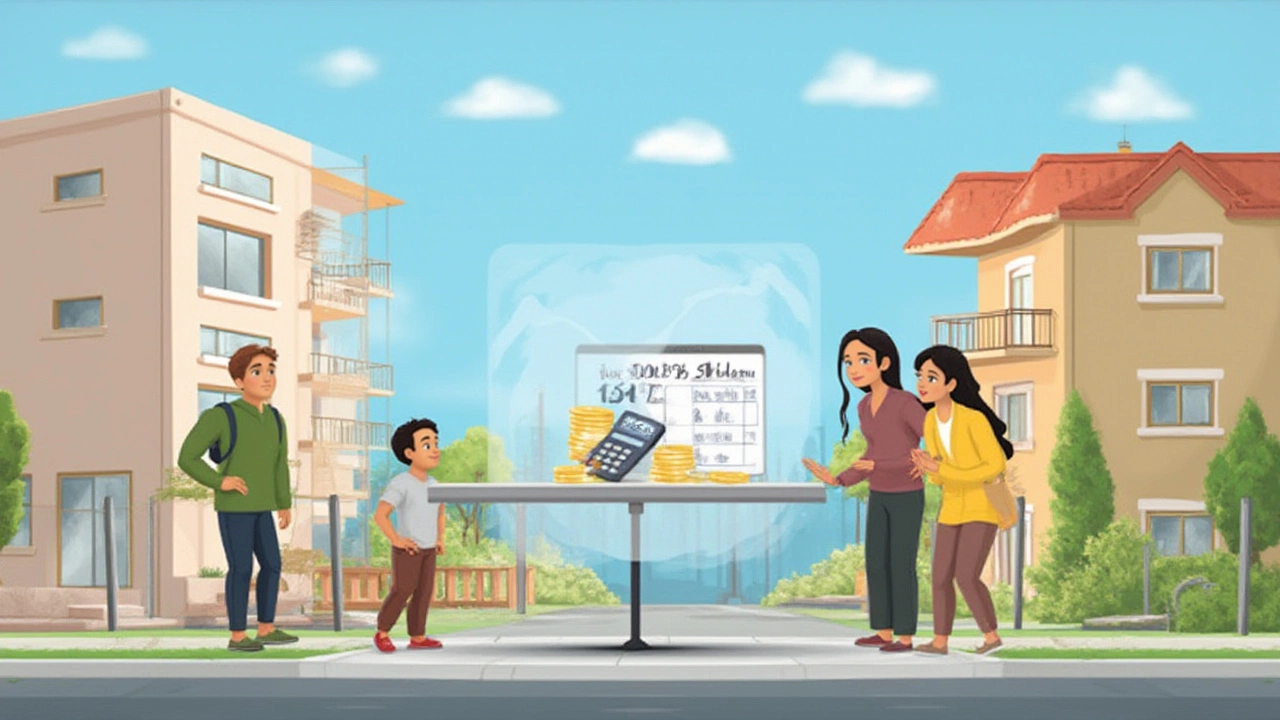The 5 percent rule is like a hidden cheat code for deciding between renting or buying a home. For years, people have argued over which side wins, tossing around words like equity and opportunity but never quite landing on a simple answer. Truth is, the right choice depends on more than just your instinct or what your uncle thinks is smart. If you run the numbers, the decision can actually get easier—and that’s where the 5 percent rule steps in. It’s not some trick dreamt up by a real estate agent; it’s what serious money nerds and smart homebuyers use to get a real look at the numbers that matter most. Hang on tight—things get way clearer when you know where your money truly goes.
How the 5 Percent Rule Works – Crunching the Numbers
You’ve probably seen calculators for down payments or mortgage rates, but the 5 percent rule zooms in on something else: the annual (not monthly!) cost of owning a home that renting simply avoids. Think about it: when you own, you don’t just pay your mortgage, you shell out for property tax, home insurance, maintenance, and the so-called cost of tying up money in your house instead of, say, investing it in the stock market. With rent, those worries aren’t yours. So here’s the formula that gets everyone talking:
- Take the home's value (what you’d pay for it if you bought today).
- Multiply it by 5% (that’s 0.05).
- Divide that number by 12 to get your monthly “ownership cost.”
For example, say you spot a neat place costing $500,000. The 5 percent rule says: $500,000 x 0.05 = $25,000 a year, or about $2,083 per month. If you could rent that same place for less than $2,083 a month, renting might be better. If it rents for more, buying could be your smarter play. Sounds ridiculously simple? That’s the beauty—this rule adds up all the costs homeowners eat that renters dodge, then wraps them up as a single number.
But why 5 percent? It bundles up the most common yearly costs:
- Property tax: On average, 1% of the home’s value per year. This can be higher in places like New Jersey or much lower if you’re chilling in Hawaii.
- Maintenance: A rough rule is 1% per year, but if Bruno chews through the baseboards, honestly, it could be more (Bruno, if you’re reading this, stop!).
- Homeowner’s insurance: About 0.5% annually, but this jumps higher in areas prone to floods or earthquakes.
- Cost of capital: This one trips people up. If you sink your savings into a home instead of stocks, you lose out on possible investment returns. Figuring this missing growth at 2.5% a year is a ballpark estimate.
Add that up: 1% tax + 1% maintenance + 0.5% insurance + 2.5% lost investment = 5%. It’s not perfect in every city, but it’s dead simple and comes close for most.
Let’s set this out in a table so you can see the numbers:
| Annual Expense | Percentage of Home Value |
|---|---|
| Property Tax | 1% |
| Maintenance | 1% |
| Insurance | 0.5% |
| Cost of Capital (lost investment return) | 2.5% |
| Total | 5% |
The 5 percent rule doesn't count your mortgage principal and interest—those are payments toward actually owning the home, not the cost of holding it. So don't confuse this number with your monthly mortgage bill. If you put down more or less, or if interest rates go up or down, the calculation shifts a little but the 5 percent rule still gives you a reliable checkpoint. Real-life landlords and big-time investors love this as a “should I sell or rent” shortcut too, because it handles all the hidden stuff regular folks forget.

Applying the 5 Percent Rule – Real-Life Decisions That Matter
No one wants to get trapped in a money pit, but most guides just repeat, "If you plan to stay 5 years, buy. Otherwise, rent!" The 5 percent rule replaces those half-baked mantras with hard numbers suiting your actual situation. Let’s dig into why the math suddenly matters, especially with mortgage rates jumping all over the place in the past few years.
If you’re sitting there with a calculator—or at least a phone—here’s how I usually lay out the numbers for friends who ping me for advice:
- Find out the current fair market value of your target home, and the rent for something similar.
- Multiply the home value by 0.05, then divide by 12 for the monthly “hard cost of owning.”
- Stack the cost of renting vs. that “ownership cost.”
- If rent’s cheaper, renting usually wins—IF (big if!) you’re not itching to customize, put in a doggie door for Bruno, or stay more than seven years. If rent’s higher, buying could deliver more bang for your buck, especially if you plan to stick around a decade or so.
This isn’t just theory. Back in 2024, Frederic Mishkin, a former Federal Reserve governor, wrote about how even a tiny percent change in mortgage rates shifts the buy/rent balance by hundreds of dollars a month. So when rates bounced up after 2021, more people suddenly found the 5 percent rule tipped the math toward renting, for the first time in a decade.
Another fun part? The 5 percent rule lets you quickly scan whole neighborhoods. Just check recent sales or listings, then see if local rent is way less than the monthly 5 percent cost. If it is, maybe that area’s overpriced and renters are getting a sweet deal—like finding a massive two-bedroom that rents for less than it would ever cost to own. Not all markets act the same. In New York or San Francisco, it’s almost always cheaper to rent. In the Midwest? Sometimes buying is a steal.
What about the big stuff nobody tells you—like future home value, rent hikes, or personal needs? The 5 percent rule isn’t magic; it’s a compass. You’ll also want to blend in your own job stability, local house appreciation, and whether you dream about painting the walls bright yellow (landlords love that, right?). If you’re planning to build a family or you’re a pet owner like me (trust me, Bruno is 80 pounds of pure opinion), sometimes the numbers come second to just needing space and stability.
A quick tip: The longer you stay, the better buying works out because up-front costs like loan origination and closing fees get “spread out” over more years. According to a 2023 Zillow survey, the average buyer moves every 13 years, but if you know you’re moving for work soon, the rent side often makes the most sense.

Tweaking the Rule for Your Life – When the 5 Percent Rule Breaks Down
No rule nails it for everyone—life’s messier than formulas let on. For some, the rule needs adjusting. Your town may have 2 percent taxes. Maybe you’d invest like Warren Buffett if you weren’t buying a home, or maybe your money would sit in a 1 percent savings account. Swap out the generic 2.5 percent "cost of capital" for your real expected stock market return.
Maintenance can throw a wrench in things too. I’ve lived in apartments where my landlord fixed everything, but a friend who bought an older Victorian spent triple the expected amount on plumbing in a single year. So, if you’re considering a fixer-upper, pad the maintenance number. If you’re eyeing brand-new construction with a warranty, maybe the estimate drops a bit. It helps to check neighborhood Facebook groups or Reddit threads for real numbers.
Don’t forget about extras like HOA fees or major insurance spikes. After wildfires in California and Florida hurricanes, insurance premiums have soared. If you live in places with big risks, use the latest numbers—don’t just trust the old rule of thumb.
Then there’s future appreciation. The 5 percent rule assumes no major change in the home’s value. If prices spike, owning could mean a huge upside. If there’s a crash—or you have to sell fast and cover agent fees—renting saves you big headaches. Redfin data from 2022 showed more first-time buyers were outbid in hot markets, but in slower years, renters could actually score better deals.
Maybe most important, the rule can’t value emotional factors. Bruno doesn’t care about mortgage rates; he loves a backyard. If you crave painting walls or tricking out a home theater, that’s huge. Freedom matters too: renters can pack up fast, owners can remodel, plant gardens, or host epic BBQs.
So, use the 5 percent rule as your starting point—the way you’d check the weather before heading out. If you love what you find, dig deeper: check your actual local numbers, talk to people living where you want to move, and maybe even ask your pet what they think. And yes, revisit the rule every year. Markets shift fast, and what’s true today could flip by next summer.
